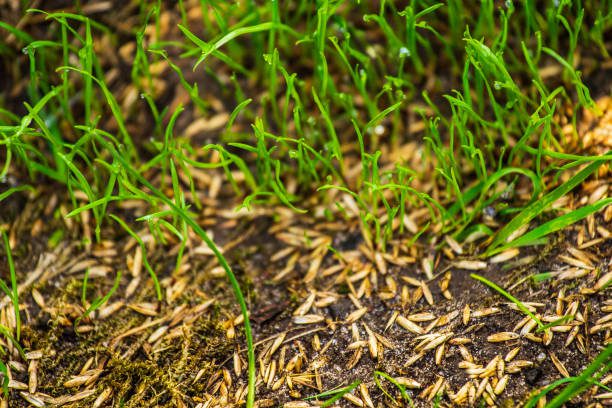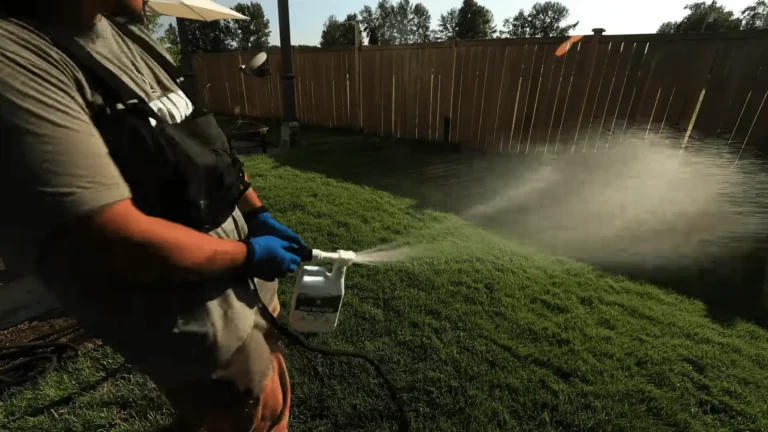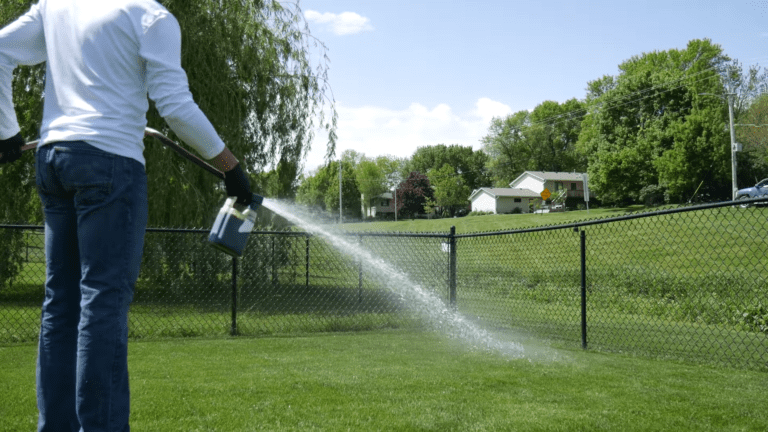Boost Your Grass: Choose the Right Spring Lawn Fertilizer Now!
Did you know that a well-fed lawn not only looks better but is also more resilient to stressors like drought and wear? That’s right, as the snow melts and the first signs of green peek through, it’s your cue to think about spring lawn care. Choosing the right fertilizer is not just a chore; it’s an art that sets the stage for your personal green canvas to flourish.
With the right blend of nutrients, your grass can transform from a winter-weary brown to a vibrant green that’s the envy of the neighborhood. It’s not just about aesthetics; it’s about creating a robust foundation for your lawn to thrive all season long. A lush lawn is a playground for memories and a front-row seat to nature’s beauty.
So, let’s get down to the roots of it. Boost your grass with the right spring lawn fertilizer now, and watch as your lawn becomes a testament to your care and attention. This isn’t just lawn maintenance; it’s a labor of love that yields visible rewards. Ready to green up your landscape? Let’s dig in and give your lawn the nutrients it craves. 🌱
Table of Contents
Selecting the Right Fertilizer
Selecting the right fertilizer for your spring lawn is a critical decision that can have a lasting impact on the health and appearance of your grass. The ideal fertilizer will provide a balanced diet of nutrients, tailored to the specific needs of your lawn as it emerges from winter dormancy. Here’s a comprehensive guide to help you make the best choice.
Understanding Lawn Nutrients
The three primary nutrients in any fertilizer are nitrogen (N), phosphorus (P), and potassium (K), commonly referred to as the NPK ratio. For spring, nitrogen is the star player because it’s essential for leaf growth and gives your lawn that vibrant green color. However, too much nitrogen can lead to rapid growth, which can stress the grass and make it more susceptible to diseases and pests.
Nitrogen Content and Release Formulas
When it comes to nitrogen, there are two main types found in fertilizers: fast-release and slow-release. Fast-release nitrogen gives your lawn a quick green-up, but it can also lead to growth spurts that require more frequent mowing. Slow-release nitrogen, on the other hand, feeds your lawn gradually over time, promoting steady growth and reducing the risk of burning the grass.
Slow-release formulas are generally preferred in the spring because they provide a consistent supply of nitrogen as the lawn transitions from the cooler weather of early spring to the warmer days that follow. They also help in fostering deep root development, which is crucial for the lawn to absorb water and nutrients effectively.
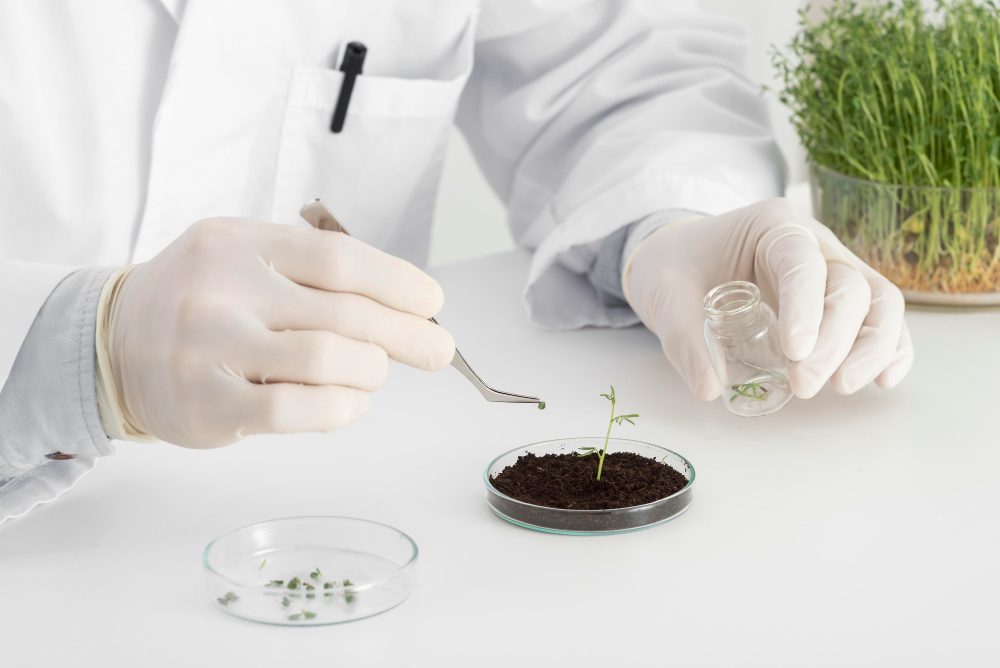
The Role of Soil Testing
Before you even begin to look at fertilizers, it’s wise to conduct a soil test. This test will reveal the pH level of your soil and any nutrient deficiencies it may have. Knowing the pH level is important because it affects the soil’s ability to hold and release nutrients to the grass. For example, if the soil is too acidic or too alkaline, certain nutrients can become locked up and unavailable to your lawn.
A soil test can also guide you in selecting a fertilizer with the right NPK ratio for your lawn’s specific needs. If the test reveals a phosphorus deficiency, you’ll want to look for a fertilizer that has a higher middle number (the P in NPK). If potassium is lacking, you’ll need a fertilizer with a higher last number (the K in NPK).
Choosing the Best Fertilizer for Spring Lawn
With the results of your soil test in hand, you can now choose a fertilizer that will best meet the needs of your lawn. If your soil test indicates that your lawn is well-balanced in phosphorus and potassium, then a fertilizer with a higher nitrogen content might be the best choice.
For lawns that have specific nutrient deficiencies, look for a fertilizer that can address those needs. For instance, if your soil test shows a lack of potassium, which is important for disease resistance and drought tolerance, select a fertilizer that has a higher amount of potassium.
Organic vs. Synthetic Fertilizers
You’ll also need to decide between organic and synthetic fertilizers. Organic fertilizers are made from natural materials and are generally slower to release nutrients, which can be beneficial for long-term lawn health. They also improve soil structure and increase biological activity. However, they may have a lower nutrient content, so you might need to apply them more frequently.
Synthetic fertilizers are man-made and can be tailored to release nutrients at a specific rate. They usually have a higher nutrient content, so you can apply them less often. However, they don’t offer the same soil health benefits as organic options.
Soil Testing and Early Spring Care
As the remnants of winter fade and the first signs of spring emerge, it’s time to think about the health of your lawn. Early spring care is crucial, and it all begins with understanding the needs of your soil through a soil test.
The Soil Test: Your Lawn’s Health Check-Up
A soil test is like a health check-up for your lawn. It measures the levels of pH, nutrients, and organic matter content, providing a clear picture of what your soil has and what it lacks. Here’s how you can conduct a soil test:
- Collect Soil Samples: Use a soil probe or shovel to collect samples from various spots in your lawn, about 3-4 inches deep.
- Mix Soil Samples: Combine the samples in a clean bucket to get a representative mix of your lawn’s overall soil condition.
- Send to a Lab: Package the mixed soil and send it to a local extension service or a professional soil testing lab.
- Interpret the Results: Once you receive the results, you’ll see recommendations for amendments to balance your soil’s pH and nutrient levels.

Maintaining optimal nutrient levels in soil is essential for a healthy lawn in spring. Here’s a table outlining various nutrients and their ideal level ranges for lawn health:
| Nutrient | Ideal Level Range |
|---|---|
| pH | 6.0 – 7.0 |
| Nitrogen (N) | 3 – 5% |
| Phosphorus (P) | 2 – 5% |
| Potassium (K) | 3 – 5% |
| Calcium (Ca) | 1000 – 3000 ppm |
| Magnesium (Mg) | 50 – 150 ppm |
| Sulfur (S) | 10 – 30 ppm |
| Iron (Fe) | 50 – 250 ppm |
| Manganese (Mn) | 10 – 100 ppm |
| Copper (Cu) | 0.5 – 5 ppm |
| Zinc (Zn) | 0.5 – 3 ppm |
| Boron (B) | 0.2 – 2 ppm |
These ranges are general guidelines and can vary based on specific grass types, soil conditions, and regional climate. It’s always recommended to conduct a soil test to determine the exact nutrient needs of your lawn.
The Role of Soil Testing in Lawn Preparation
The results of a soil test are invaluable. They tell you exactly what your lawn needs to thrive:
- pH Level Adjustment: If your soil is too acidic or alkaline, it can hinder grass growth. Lime can be added to raise pH, while sulfur can lower it.
- Nutrient Supplementation: The test will reveal deficiencies in key nutrients like nitrogen, phosphorus, and potassium, which are vital for root development and disease resistance.
Choosing the Right Early Spring Lawn Fertilizer
With the knowledge gained from a soil test, you can make an informed decision on the right fertilizer for your lawn:
- Nitrogen-Rich Fertilizers: Look for fertilizers with a higher nitrogen content to encourage vigorous leaf growth.
- Balanced Fertilizers: If your soil test shows a balanced need for nutrients, choose a fertilizer with an even NPK ratio.
- Slow-Release Formulas: These fertilizers release nutrients over time, promoting consistent growth and reducing the risk of nutrient run-off.
Encouraging Deep Roots
Deep roots are the foundation of a healthy lawn. Here are some tips to encourage deep root growth:
- Proper Watering: Water deeply but infrequently to encourage roots to grow downward in search of moisture.
- Aeration: Aerating your lawn can help improve oxygen circulation and nutrient absorption, promoting deeper roots.
- Appropriate Mowing: Keeping your grass at the right height can encourage root growth and prevent stress.
Application Techniques for Spring Lawn Fertilization
Spring is a critical time for lawn care, and applying fertilizer correctly is key to promoting healthy growth. Here’s a comprehensive guide to ensure you fertilize your lawn effectively this spring.

Step-by-Step Guide to Fertilizing Your Lawn
Step 1: Choose the Right Fertilizer Based on a soil test, select a fertilizer with the appropriate NPK ratio. For spring, focus on nitrogen-rich formulas, preferably with slow-release nitrogen to ensure steady growth.
Step 2: Read the Instructions Before you begin, read the manufacturer’s instructions on the fertilizer package. This will provide guidance on how much fertilizer to use per square foot of lawn.
Step 3: Prepare Your Lawn Mow your lawn to an appropriate height and rake up any leaves or debris. This ensures the fertilizer can reach the soil and roots easily.
Step 4: Calibrate Your Spreader If you’re using a broadcast or drop spreader, calibrate it according to the instructions. This ensures even distribution of the fertilizer.
Step 5: Fill the Spreader Fill your spreader with the recommended amount of fertilizer for the size of your lawn. Avoid spilling fertilizer on hard surfaces where it can wash away into water systems.
Step 6: Apply the Fertilizer Start around the edges of your lawn and then move back and forth across the grass in an orderly pattern. Overlap slightly on each pass to avoid stripes of unfertilized grass.
Step 7: Water Your Lawn After applying the fertilizer, water your lawn lightly to help the fertilizer soak into the soil. However, avoid over-watering, which can cause run-off.
Step 8: Clean Up Sweep any fertilizer granules that have landed on sidewalks or driveways back onto the lawn to prevent pollution.
Ensuring Deep Roots
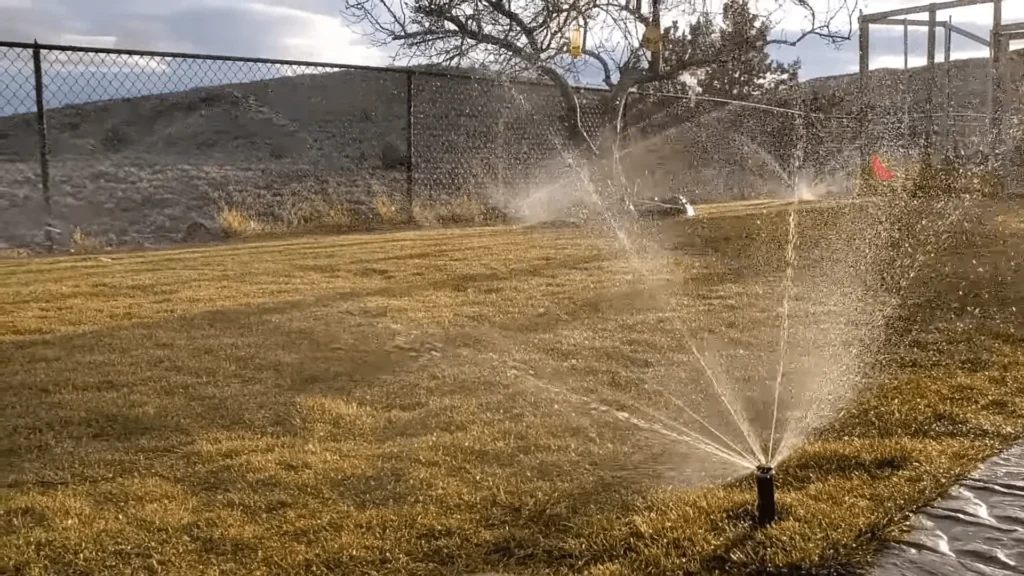
Deep Watering Water deeply and infrequently to encourage roots to grow deeper in search of moisture. This helps establish a more drought-resistant lawn.
Proper Mowing Keep your grass at a height of about 2.5 to 3 inches. Taller grass promotes deeper root growth and shades the soil, reducing evaporation.
Aeration Consider aerating your lawn to alleviate soil compaction. This allows air, water, and nutrients to penetrate deeper into the soil, promoting root growth.
Common Errors and How to Avoid Them
Over-Fertilizing Applying too much fertilizer can burn your lawn and lead to excessive growth. Stick to the recommended rates on the fertilizer package.
Uneven Application Avoid uneven application, which can cause patchy growth. Use a spreader for consistent coverage.
Ignoring Weather Conditions Don’t fertilize before heavy rain, as this can wash away the fertilizer. Also, avoid fertilizing during drought conditions when the lawn is stressed.
Neglecting Soil Health Remember that fertilizer is not a cure-all. Good soil health is essential for a healthy lawn. Regularly test your soil and amend it as needed.
Using the Wrong Type of Fertilizer Not all fertilizers are suitable for all lawns. Choose a turf builder or lawn food specifically designed for your type of grass and climate.
Forgetting Safety Always wear gloves and protective clothing when handling fertilizer. Keep pets and children off the lawn until the fertilizer has been watered in and dried.
Conclusion
By following these steps and avoiding common errors, you can apply fertilizer to your lawn this spring with confidence. Remember, the goal is to provide your lawn with the nutrients it needs for healthy growth without causing damage or pollution. With careful application and attention to detail, you can ensure your lawn remains a beautiful and vibrant part of your home throughout the season. 🌱
Scheduling Fertilization: Timing is Everything for a Healthy Spring Lawn
When it comes to lawn care, timing your fertilization correctly is as crucial as selecting the right fertilizer. The spring season is a period of awakening for your lawn, and the application of fertilizer should align with this natural growth cycle to ensure optimal health and vigor.

The Best Time to Fertilize Lawn in Spring
The ideal time to fertilize your lawn in spring is when the soil temperature reaches about 55 degrees Fahrenheit. This is typically when you’ll notice the first flush of green as your grass exits dormancy and begins active growth. In most regions, this corresponds to the period when forsythia bushes bloom and before the onset of the hot summer months.
Importance of Timing
Proper timing supports the growing season by providing your lawn with the nutrients it needs just as it’s ready to grow. Early spring fertilization helps strengthen roots, giving your grass a solid foundation to withstand the stresses of summer, such as heat and drought. Conversely, fertilizing too early can waste nutrients if the grass isn’t ready to absorb them, and fertilizing too late can stress the lawn during the hotter parts of the year.
Influence of Early Spring Weather Patterns
Early spring weather patterns play a significant role in determining the best time to fertilize. A mild winter followed by an early spring might mean you’ll need to fertilize sooner than usual. On the other hand, a late frost or prolonged cold snap can delay the start of the growing season, pushing back your fertilization schedule.
Monitoring Soil Temperature
To precisely gauge the right time to fertilize, monitor the soil temperature using a soil thermometer. Alternatively, pay attention to local weather reports and nature’s cues, such as blooming plants and the consistent growth of grass.
Adjusting to Weather Variability
Be prepared to adjust your fertilization schedule based on weather variability. If a sudden cold front is forecasted after you’ve fertilized, be ready to provide extra care to your lawn, such as additional watering, to mitigate any potential damage.
In conclusion, the best time to fertilize your lawn in spring is when your grass is actively growing and can make the most of the nutrients provided. By understanding and responding to early spring weather patterns, you can ensure that your fertilization efforts support a robust growing season. Remember, a well-timed fertilization can set the tone for the health and beauty of your lawn throughout the year. 🌱
Spring lawn fertilizer numbers
A lush, green lawn is the hallmark of a well-maintained garden. Achieving this requires not just regular care, but also an understanding of the different types of fertilizers and how they cater to the lawn’s life cycle and the changing weather patterns. Let’s delve into the world of lawn fertilizers, decipher the numbers, and determine the best NPK ratios for each stage of spring.
The Life Cycle of Your Lawn and Fertilizer Needs
Early Spring (Revival): After the dormancy of winter, your lawn enters a revival phase in early spring. The soil begins to warm up, and the grass roots start to activate. During this period, your lawn benefits from a balanced fertilizer that encourages both root development and leaf growth. An NPK ratio of 16-4-8 or 20-5-10 is ideal, providing a boost of nitrogen for green-up, phosphorus for root growth, and potassium for overall health.
Mid Spring (Growth): As the season progresses and temperatures rise, your lawn enters a vigorous growth phase. This is when you need to support this growth with a slightly higher nitrogen content. A ratio of 24-0-12 can be effective, focusing on nitrogen for growth and potassium to enhance stress tolerance, especially as the weather gets warmer.
Late Spring (Preparation for Heat): In late spring, it’s crucial to prepare your lawn for the upcoming heat of summer. A fertilizer with a lower nitrogen content and higher potassium levels can help. An NPK ratio of 15-0-15 or 13-13-13 will support the grass in strengthening its roots and increasing its drought and heat resistance.
Weather Patterns and Spring lawn Fertilizer Choices
The weather plays a significant role in determining the type of fertilizer you should use. In areas with wet springs, slow-release or controlled-release nitrogen fertilizers are preferable to minimize leaching and run-off. In contrast, in regions with dry springs, quick-release fertilizers might be necessary to give the grass a rapid green-up, followed by regular irrigation.
Understanding the relationship between weather patterns and fertilizer choices is crucial for lawn care enthusiasts. Different regions in the USA experience varied climates, which influence the type of fertilizer that should be used. Here’s a table that outlines when spring starts in various counties, the typical weather patterns, and the recommended fertilizers for lawns in those regions during spring:
| County | Region | Spring Start | Weather Pattern | Recommended Fertilizer | NPK Ratio |
|---|---|---|---|---|---|
| Omaha, NE | Midwest | 20 days early | Variable, can be wet | Slow-release nitrogen fertilizer | High N |
| Indianapolis, IN | Midwest | 14 days early | Mild, occasional rain | Balanced NPK, higher in nitrogen | Balanced, High N |
| New York City, NY | Northeast | 10 days early | Cool, gradual warming | High nitrogen content for growth | High N |
| Los Angeles, CA | West | Average | Dry, mild | Organic fertilizer with low phosphorus | Low P |
| Miami, FL | South | Average | Warm, humid | Fertilizer with high potassium for heat stress | High K |
| Seattle, WA | Northwest | Average | Wet, cool | Slow-release, water-soluble fertilizer | – |
| Dallas, TX | South | Average | Variable, often dry | Fertilizer with high nitrogen and potassium | High N, High K |
| Chicago, IL | Midwest | 7 days early | Cool, wet | Balanced NPK fertilizer | Balanced |
| Phoenix, AZ | Southwest | 5 days late | Hot, dry | Fertilizer with low nitrogen | Low N |
| Denver, CO | West | 3 days early | Variable, can be snowy | Slow-release nitrogen fertilizer | High N |
The start dates for spring are based on the average arrival of spring for each area compared to historical records1. The weather patterns are generalized and can vary year to year. For instance, Omaha, NE, typically experiences variable spring weather, which can include wet conditions that are conducive to using slow-release nitrogen fertilizers to minimize leaching and run-off. In contrast, Los Angeles, CA, with its drier climate, may benefit from organic fertilizers that are lower in phosphorus to prevent overstimulation of leaf growth at the expense of root development.
It’s important to note that these are general recommendations and that a soil test is the best way to determine the specific needs of your lawn. Additionally, always follow the manufacturer’s instructions when applying any fertilizer to ensure the safety and health of your lawn.
Deciphering Fertilizer Numbers
Fertilizer bags come with three numbers, known as the NPK ratio, which stands for Nitrogen (N), Phosphorus (P), and Potassium (K). These numbers represent the percentage of each nutrient in the fertilizer.
- Nitrogen (N) is for green leaf growth.
- Phosphorus (P) is for root and flower development.
- Potassium (K) is for overall plant health and disease resistance.
For example, a bag labeled 10-10-10 is a balanced fertilizer with equal parts of each nutrient. A bag labeled 20-0-10 has twice as much nitrogen as potassium and no phosphorus.
Spring lawn fertilization tips

When it comes to spring lawn fertilization, there’s more to consider than just the primary nutrients of nitrogen (N), phosphorus (P), and potassium (K). Here are some tips for spring fertilization, including the importance of secondary nutrients:
- Water Before Fertilizing: Ensure your lawn is hydrated a few days before you fertilize to prevent burning the roots1.
- Weed Control: If you have weed issues, consider a fertilizer that includes a pre-emergent herbicide for crabgrass or a weed-and-feed product for broadleaf weeds.
- Proper Timing: Fertilize your lawn when the grass is actively growing. For cool-season grasses, this is typically in early spring and fall, while warm-season grasses benefit from fertilization in late spring through summer.
- Application Technique: Apply fertilizer evenly across the lawn using a spreader, and water lightly afterward to help the nutrients soak into the soil.
- Avoid Over-Fertilizing: Stick to the recommended application rates to prevent nutrient run-off and potential environmental damage.

Secondary Nutrients:
- Calcium (Ca): Improves plant vigor and promotes the growth of young roots and shoots.
- Magnesium (Mg): Regulates nutrient uptake, aids seed formation, and contributes to the dark green color of leaves for effective photosynthesis.
- Sulfur (S): Maintains the dark green color and encourages vigorous plant growth.
These secondary nutrients are essential for overall lawn health and should not be overlooked. They often come from the soil itself but can be added through specific fertilizers or soil amendments if a soil test indicates a deficiency. Always start with a soil test to determine the exact needs of your lawn before applying any fertilizers. 🌱
Recommended spring lawn fertilizer
1. Espoma Organic Lawn Food Spring Lawn Booster
Overview: Espoma Organic Lawn Food Spring Lawn Booster is designed to provide a natural and effective way to nourish your lawn during the crucial growing period of spring. This organic fertilizer is derived from feather meal, poultry manure, and gypsum, offering a non-burning, slow-release formula that’s safe for the environment.
Alright, let me spin you a yarn about my experience with Espoma Organic Lawn Food Spring Lawn Booster. As a self-proclaimed lawn aficionado, I’ve seen my fair share of grassy knolls and sod battles. So when spring rolls around, I’m all about that green-up.
Now, picture this: I’m out there in my yard, the sun’s shining, birds are chirping, and I’m armed with my trusty spreader and a bag of Espoma’s finest. This stuff is like the secret sauce for lawns – it’s organic, which means I’m not just feeding my grass; I’m saving the planet one square foot at a time.
Features? You betcha. It’s got slow-release nitrogen, which is like a fine dining experience for my lawn. No fast food rush here; it’s all about savoring the flavor. And it’s got calcium too, which is like the multivitamin of the soil world, keeping everything in tip-top shape.
Pros? My lawn is looking lush, like a green carpet rolled out just for me. And it’s safe for the kiddos and my dog, Rufus, to roll around on immediately after application. Plus, it’s easy to apply – if you can walk and push a spreader, you’re golden.
Cons? Patience, grasshopper. Organic means it’s not an overnight success. And you might have to apply it a bit more often, but hey, that’s just more quality time with your lawn, right?
Tips for Optimized Results? Stick to the script – follow the bag’s instructions. Water it in just right, not too much, not too little. And keep up with the mowing; nobody likes a shaggy lawn.
So there you have it, my tale of lawn triumph. With Espoma Organic Lawn Food Spring Lawn Booster, I’m the neighborhood lawn whisperer. Green, clean, and organic – that’s how I roll. 🌱💪
2. Scotts Turf Builder Lawn Food
Let me tell ya, when it comes to turning my lawn into the emerald envy of the neighborhood, Scotts Turf Builder Lawn Food is my go-to wingman. With an NPK ratio that’s off the charts at 32-0-4, this bad boy delivers a high-octane nitrogen kick that gets my grass greener than a leprechaun’s wardrobe in no time flat.
Pros? Oh, baby, let me count the ways. We’re talking quick results that’ll have you seeing green faster than you can say “shamrock shake.” And coverage? Whether you’ve got a postage stamp patch or a football field out back, this stuff spreads like gossip in a small town, covering every inch of your lawn with nutrient-rich goodness.
Cons? Sure, it’s got a chemical edge that could make Mother Nature raise an eyebrow, so you gotta play by the rules. Use it wisely, or you might just find yourself on the wrong side of the environmental tracks.
Now, for the safety spiel: Keep this stuff sealed up tighter than Fort Knox and out of reach from your curious critters and kiddos. And when it comes to laying it down, don’t go overboard. Stick to the script, or you’ll be washing more green down the drain than a rookie at a poker table.
So there you have it, folks. Scotts Turf Builder Lawn Food: the secret sauce for a lawn that’s less “meh” and more “wowza!” 🌱💚
3. Miracle-Gro Water Soluble Lawn Food
Let me paint you a picture of my latest escapade with Miracle-Gro Water Soluble Lawn Food. Imagine me, your average Joe Lawn Lover, standing in the midst of my suburban savannah, hose-end sprayer in hand, ready to unleash a tidal wave of nutrients with a flick of my thumb.
Now, this Miracle-Gro stuff has an NPK ratio of 36-0-6, which in layman’s terms means it’s like a turbo-charged snack for my grass. And let me tell you, it’s as easy to use as pie. Hook it up to your hose, and voilà, you’re the maestro of a green symphony.
Pros? You betcha. It’s like giving your lawn an espresso shot; that green-up is almost instant. And the even distribution? It’s like butter on toast, smooth and spread just right.
Cons? Well, nobody’s perfect. You’ll be out there more often than with those slow-release types, giving your lawn its fix. But hey, it keeps you fit and your lawn fed, so it’s a win-win.
Safety Tips? Listen up, because this is important. Mix it like you’re making your grandma’s secret sauce – just right. Too strong and you’ll scorch your precious green babies. And keep an eye on the sky, because if rain’s on the horizon, you might as well be pouring your dollars down the drain.
So there you have it, folks. Miracle-Gro Water Soluble Lawn Food: the quick fix for a lawn that’s looking a little lackluster. Just remember, with great fertilizing power comes great responsibility. 🌱💦
check out this video for tips on how to take care of lawn in spring
FAQs
Can I fertilize my lawn in spring if I overseeded in the fall?
Yes, you can fertilize in spring even if you overseeded in the fall. It’s important to use a fertilizer that’s appropriate for young grass, typically one with a balanced NPK ratio and lower nitrogen content to avoid burning the tender new shoots.
How does the type of grass affect my fertilization schedule?
Different grass types have varying nutrient needs and growth patterns. Cool-season grasses like Kentucky bluegrass and fescue benefit from fertilization in early spring and fall, while warm-season grasses like Bermuda and Zoysia prefer late spring to summer fertilization.
Should I fertilize before or after rain?
It’s best to fertilize after a light rain or watering, as the moisture helps the fertilizer to dissolve and penetrate the soil. However, heavy rain can wash away the fertilizer, so avoid fertilizing if a storm is forecasted.
How do I know if my lawn is over-fertilized?
Signs of over-fertilization include yellowing or browning of grass, excessive growth, and fertilizer burn. If you suspect over-fertilization, water your lawn deeply to help flush out the excess nutrients.
Can lawn fertilization impact local wildlife and insects?
Yes, the use of certain fertilizers can impact local ecosystems. To minimize negative effects, opt for organic or slow-release fertilizers, and follow the recommended application rates and timings.
Is it necessary to fertilize every part of my lawn equally?
Not necessarily. Areas of your lawn that receive more sunlight or have different soil conditions may require different fertilization approaches. Conducting a soil test can help determine the specific needs of different lawn areas.


